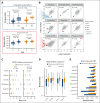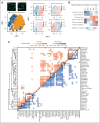Comparing the value of mono- vs coculture for high-throughput compound screening in hematological malignancies
- PMID: 37352275
- PMCID: PMC10558604
- DOI: 10.1182/bloodadvances.2022009652
Comparing the value of mono- vs coculture for high-throughput compound screening in hematological malignancies
Abstract
Large-scale compound screens are a powerful model system for understanding variability of treatment response and discovering druggable tumor vulnerabilities of hematological malignancies. However, as mostly performed in a monoculture of tumor cells, these assays disregard modulatory effects of the in vivo microenvironment. It is an open question whether and to what extent coculture with bone marrow stromal cells could improve the biological relevance of drug testing assays over monoculture. Here, we established a high-throughput platform to measure ex vivo sensitivity of 108 primary blood cancer samples to 50 drugs in monoculture and coculture with bone marrow stromal cells. Stromal coculture conferred resistance to 52% of compounds in chronic lymphocytic leukemia (CLL) and 36% of compounds in acute myeloid leukemia (AML), including chemotherapeutics, B-cell receptor inhibitors, proteasome inhibitors, and Bromodomain and extraterminal domain inhibitors. Only the JAK inhibitors ruxolitinib and tofacitinib exhibited increased efficacy in AML and CLL stromal coculture. We further confirmed the importance of JAK-STAT signaling for stroma-mediated resistance by showing that stromal cells induce phosphorylation of STAT3 in CLL cells. We genetically characterized the 108 cancer samples and found that drug-gene associations strongly correlated between monoculture and coculture. However, effect sizes were lower in coculture, with more drug-gene associations detected in monoculture than in coculture. Our results justify a 2-step strategy for drug perturbation testing, with large-scale screening performed in monoculture, followed by focused evaluation of potential stroma-mediated resistances in coculture.
© 2023 by The American Society of Hematology. Licensed under Creative Commons Attribution-NonCommercial-NoDerivatives 4.0 International (CC BY-NC-ND 4.0), permitting only noncommercial, nonderivative use with attribution. All other rights reserved.
Conflict of interest statement
Conflict-of-interest disclosure: The authors declare no competing financial interests.
Figures






Similar articles
-
Bone marrow stroma-induced resistance of chronic lymphocytic leukemia cells to arsenic trioxide involves Mcl-1 upregulation and is overcome by inhibiting the PI3Kδ or PKCβ signaling pathways.Oncotarget. 2015 Dec 29;6(42):44832-48. doi: 10.18632/oncotarget.6265. Oncotarget. 2015. PMID: 26540567 Free PMC article.
-
JAK1/2 and BCL2 inhibitors synergize to counteract bone marrow stromal cell-induced protection of AML.Blood. 2017 Aug 10;130(6):789-802. doi: 10.1182/blood-2016-02-699363. Epub 2017 Jun 15. Blood. 2017. PMID: 28619982
-
Microenvironmental stromal cells abrogate NF-κB inhibitor-induced apoptosis in chronic lymphocytic leukemia.Haematologica. 2018 Jan;103(1):136-147. doi: 10.3324/haematol.2017.165381. Epub 2017 Nov 9. Haematologica. 2018. PMID: 29122993 Free PMC article.
-
Updates on Hematologic Malignancies in the Older Adult: Focus on Acute Myeloid Leukemia, Chronic Lymphocytic Leukemia, and Multiple Myeloma.Curr Oncol Rep. 2019 Mar 8;21(4):35. doi: 10.1007/s11912-019-0778-2. Curr Oncol Rep. 2019. PMID: 30848394 Free PMC article. Review.
-
Beyond bystanders: Myeloid cells in chronic lymphocytic leukemia.Mol Immunol. 2019 Jun;110:77-87. doi: 10.1016/j.molimm.2017.11.014. Epub 2017 Nov 22. Mol Immunol. 2019. PMID: 29173971 Review.
Cited by
-
Bone marrow stromal cells enhance differentiation of acute myeloid leukemia induced by pyrimidine synthesis inhibitors.Am J Physiol Cell Physiol. 2024 Nov 1;327(5):C1202-C1218. doi: 10.1152/ajpcell.00413.2024. Epub 2024 Sep 16. Am J Physiol Cell Physiol. 2024. PMID: 39279497 Free PMC article.
-
Drug-microenvironment perturbations reveal resistance mechanisms and prognostic subgroups in CLL.Mol Syst Biol. 2022 Aug;18(8):e10855. doi: 10.15252/msb.202110855. Mol Syst Biol. 2022. PMID: 35959629 Free PMC article.
-
Morphological profiling for drug discovery in the era of deep learning.Brief Bioinform. 2024 May 23;25(4):bbae284. doi: 10.1093/bib/bbae284. Brief Bioinform. 2024. PMID: 38886164 Free PMC article. Review.
-
Conditional lethality profiling reveals anticancer mechanisms of action and drug-nutrient interactions.Sci Adv. 2024 Oct 4;10(40):eadq3591. doi: 10.1126/sciadv.adq3591. Epub 2024 Oct 4. Sci Adv. 2024. PMID: 39365851 Free PMC article.
-
Gas-Phase Fractionation Data-Independent Acquisition Analysis of 3D Cocultured Spheroid Tumor Model Reveals Altered Translational Processes and Signaling Using Proteomics.J Proteome Res. 2024 Aug 2;23(8):3188-3199. doi: 10.1021/acs.jproteome.3c00786. Epub 2024 Feb 27. J Proteome Res. 2024. PMID: 38412258 Free PMC article.
References
Publication types
MeSH terms
LinkOut - more resources
Full Text Sources
Medical
Miscellaneous

